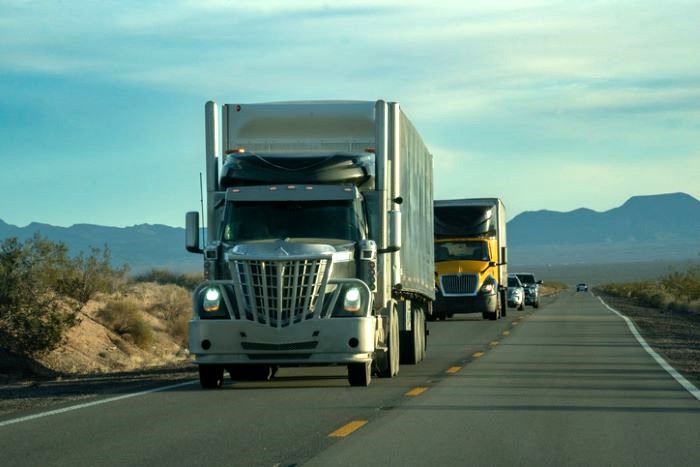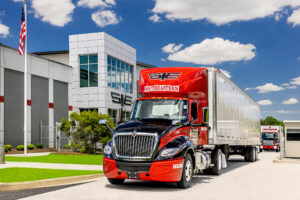WASHINGTON — A national nonprofit organization that studies, among other things, freight movement in the U.S., has issued a new report showing how the industry is being transformed.
Things like advances in vehicle autonomy, manufacturing, warehousing and supply chain automation, increasing e-commerce and the growing logistic networks being developed to accommodate consumer demand for faster delivery all play key roles, according to TRIP.
TRIP’s report, America’s Rolling Warehouses: Opportunities and Challenges with the Nation’s Freight Delivery System, examines current and projected levels of freight movement in the U.S., large truck safety, and trends impacting freight movement.
Freight delivery is expected to increase rapidly due to economic growth, increasing demand, changing business and retail models and a significantly increased reliance on e-commerce, according to TRIP.
Additionally, TRIP’s report concludes with a series of recommendations to improve the nation’s freight transportation system.
The report’s appendix includes data for all 50 states in the following categories:
- Amount of freight moved by weight and value (overall and by truck);
- Projected increase in weight and value of freight shipped from 2022 to 2050;
- Share of interstate travel by combination trucks; and
- The number of traffic fatalities involving large trucks.
While the amount and value of goods being shipped have risen to unprecedented levels, traffic congestion is increasing the cost of moving freight and reducing the economic competitiveness and efficiency of businesses that require reliable, affordable freight transportation, according to the study.
Traffic congestion resulted in $94.6 billion in additional operational costs to the trucking industry in 2022 as a result of commercial trucks being stuck in traffic for 1.3 billion hours. U.S. business logistics costs reached $2.3 trillion in 2022, representing 9.1% of U.S. GDP — the highest share ever.
According to the TRIP report, from 2017 to 2021, the number of fatalities in crashes involving large trucks in the U.S. increased 18%, from 4,906 to 5,788. Approximately five out of six people killed in crashes involving a large truck were occupants of the other vehicle involved in the crash, pedestrians or bicyclists.
While large trucks account for 5% of all registered vehicles and 10% of all vehicle miles of travel annually, 13% of traffic fatalities occur in traffic crashes in which a large truck was involved. The most frequent event prior to fatal crashes between large trucks and another vehicle is the entering or encroaching into a large truck’s lane by the other vehicle.
“U.S. manufacturers have proven remarkable resilience following persistent supply chain disruptions that have impacted our operations, led to longer lead times on many things like components, and a left us with a tight labor market,” said Todd Stucke, incoming president of Kubota Tractor Corp. and executive officer of Kubota Corp., as well as chair of the Association of Equipment Manufacturers.
“This unpredictability means that we must be laser focused on maintaining the health, safety, and efficiency of our freight transportation network. This is vital to making sure U.S. manufacturers can continue to adapt and meet the demand for our world-class products domestically and remain competitive globally,” he continued.
Bill Sullivan, chief public affairs and advocacy officer for the American Trucking Associations, said the report “describes in stark detail the current and future challenges that the trucking industry must overcome to meet the nation’s supply chain needs. Increased public investment in highway capacity expansion, truck parking facilities and other critical highway infrastructure is essential to improving highway safety and freight efficiency. The report’s recommendations provide a great roadmap for lawmakers to address the highway system’s deficiencies.”
Multiple technological advances will transform how freight is delivered in the future, according to TRIP.
These include:
- The growing use of artificial intelligence, which is driving manufacturing and increasing the efficiency of logistics;
- Increased automation in warehousing and supply chains;
- Expanded growth and reliance on e-commerce;
- Changing global logistics patterns; advances in vehicle autonomy; and
- The transition to environmentally friendlier fuels to reduce transportation greenhouse gas emissions.
A lack of adequate parking for large trucks and a shortage of available truck drivers, particularly for long-haul trips, challenge the safety and efficiency of the nation’s freight system, the report stresses.
In the past decade, U.S. retail e-commerce sales increased nearly four and a half times, from $64 billion in the second quarter of 2013 to $278 billion in the second quarter of 2023. The COVID-19 pandemic rapidly accelerated the growth in retail e-commerce, with U.S. e-commerce sales increasing from $160 billion in the first quarter of 2020 to $278 billion in the second quarter of 2023 — a 73% increase.
“As Congress prepares to consider major legislation reauthorizing our national highway system, TRIP’s report highlights the vital role the nation’s freight transportation plays in the lives of Americans and offers a set of practical and effective recommendations to generate the investment, innovation and collaboration to ensure the continued viability of our nation’s freight network and supply chain,” said John Drake, vice president for transportation, infrastructure and supply chain policy at the U.S. Chamber of Commerce.
TRIP’s report concludes with a series of recommendations to improve freight transportation:
- Increase capacity on the nation’s freight transportation system, particularly at major bottlenecks;
- Improve the reliability and condition of intermodal connectors between major highways and rail, ports, and waterways;
- Continue development of vehicle autonomy and the further automation of warehousing;
- Improve roadway safety and providing additional truck parking spaces to ensure adequate and timely rest for drivers;
- Provide funding for freight transportation improvements that is substantial, continuing, multimodal, reliable and, in most cases, specifically dedicated to freight transportation projects; and
- Provide a permanent, adequate and reliable funding fix to the federal Highway Trust Fund as a critical step towards funding a 21st century freight transportation system.
“As consumers demand faster deliveries and a more responsive supply chain, the nation’s freight transportation network is facing unprecedented roadblocks in the form of increasing congestion and a lack of transportation funding to improve the nation’s transportation system,” said David Kearby, executive director of TRIP. “A long-term, sustainable source of revenue that supports needed transportation investment will be crucial to improving the efficiency and safety of America’s freight transportation system.”
State-by-state breakdown (partial)
Alabama
In 2022, Alabama’s freight system moved 590 million tons of freight valued at $448 billion. From 2022 to 2050, freight moved annually in Alabama by trucks is expected to increase 93% in value (inflation-adjusted dollars) and 59% by weight. The TRIP report also found that 15% of travel on Alabama’s interstate highways and 20% of travel on its rural interstate highways is by combination trucks.
From 2017 to 2021, an average of 130 people were killed each year in Alabama in collisions involving a large truck, approximately 26 annual fatalities per 100 million population.
“Alabama has seen a marked CMV (commercial motor vehicle) fatal crash reduction in 2022 and 2023,” said Captain T. E. Pullin, motor carrier safety unit commander for the Alabama Law Enforcement Agency (ALEA). “A collaborative effort between ALEA, Alabama Trucking Association, and the Federal Motor Carrier Safety Administration has yielded an approximate 27% CMV fatal crash reduction improvement from the 2017 to 2021 CMV fatal crash rate averages.”
Arkansas
The TRIP report also found that 28% of travel on Arkansas’ interstate highways and 34% of travel on its rural interstate highways is by combination trucks — the third highest share in the nation. From 2017 to 2021, an average of 91 people were killed annually in Arkansas in collisions involving a large truck, approximately 30 annual fatalities per 100 million population, marking the fourth highest rate in the nation. In 2022 Arkansas’ freight system moved 322 million tons of freight, valued at $225 billion. From 2022 to 2050, freight moved annually in Arkansas by trucks is expected to increase 63% by weight and 96% by value (inflation-adjusted dollars) — the 19th highest increase in the U.S.
California
In 2022, California’s freight system moved 1.4 billion tons of freight valued at $2.8 trillion — the second largest value of freight moved of all states. From 2022 to 2050, freight moved annually in California by trucks is expected to increase 65% by weight and 100% by value (inflation-adjusted dollars), the eighth highest increase in the U.S. The TRIP report also found that 11% of travel on California’s interstate highways and 19% of travel on its rural interstate highways is by combination trucks. From 2017 to 2021, an average of 391 people were killed each year in California in collisions involving a large truck, approximately 10 annual fatalities per 100 million population.
“The most recent TRIP report highlights the importance of California’s infrastructure in facilitating international commerce,” said Jennifer Barrera, president and CEO of CalChamber. “Our state must continue to make investments in infrastructure because it is critical to the success of our current and future economy.”
Colorado
In 2022, Colorado’s freight system moved 344 million tons of freight valued at $326 billion. From 2022 to 2050, freight moved annually in Colorado by trucks is expected to increase 104% by value (inflation-adjusted dollars) — the sixth highest projected increase in the U.S. — and 63% by weight. The TRIP report also found that 8% of travel on Colorado’s Interstate highways and 13 % of travel on its rural Interstate highways is by combination trucks. From 2017 to 2021, an average of 93 people were killed annually in Colorado in collisions involving a large truck, approximately 16 annual fatalities per 100 million population.
“Colorado’s significant growth over the past 20 years has brought a substantial increase in freight movement. This growth, coupled with greater on-line sales and local delivery volumes, is adding further stress on a transportation network that has seen only marginal increases in highway capacity,” said Greg Fulton, president of the Colorado Motor Carriers Association.
Florida
In 2022, Florida’s freight system moved 839 million tons of freight valued at $1.1 trillion — the eighth largest value of freight moved of all states. From 2022 to 2050, freight moved annually in Florida by trucks is expected to increase 94% by value (inflation-adjusted dollars) and 58% by weight. The TRIP report also found that 9% of travel on Florida’s interstate highways and 16% of travel on its rural interstate highways is by combination trucks. From 2017 to 2021, an average of 336 people were killed each year in Florida in collisions involving a large truck, approximately 15 annual fatalities per 100 million population.
“The top priority of the trucking industry is to move freight safely and efficiently,” said Alix Miller, president and CEO of the Florida Trucking Association. “Florida is ranked the third worst in the country for congestion, costing the industry more than $7.1 billion a year. Congestion also has a negative effect on safety, increasing the rate of crashes, especially with trucks unable to maintain a safe distance from other motorists. An investment in infrastructure improves the movement of goods, thereby bolstering the economy, and keeps us all safer on our roads.”
Georgia
In 2022, Georgia’s freight system moved 629 million tons of freight valued at $986 billion — the tenth largest value of freight moved of all states. From 2022 to 2050, freight moved annually in Georgia by trucks is expected to increase 67% by weight and 96% in value (inflation-adjusted dollars), the 18th highest increase in the U.S. The TRIP report also found that 15% of travel on Georgia’s interstate highways and 21% of travel on its rural interstate highways is by combination trucks. From 2017 to 2021, an average of 217 people were killed annually in Georgia in collisions involving a large truck, approximately 20 annual fatalities per 100 million population.
“Georgia has been ranked the No. 1 state to do business for 10 years in a row by Site Selection magazine, and as such have seen significant growth over the decade,” said Russell McMurry, commissioner of the Georgia Department of Transportation. “The Georgia Department of Transportation has its hands full trying to plan for and deliver the infrastructure necessary that keeps Georgia competitive when it comes to the costs associated with unreliable trips, speed and costs to business. We estimate additional funding in the billions dollars of investment will be needed to start addressing this exceptional growth.”
Iowa
In 2022, Iowa’s freight system moved 638 million tons of freight valued at $377 billion. The TRIP report also found that 22% of travel on Iowa’s interstate highways and 27% of travel on its rural interstate highways is by combination trucks — the eighth highest share in the nation. From 2022 to 2050, freight moved annually in Iowa by trucks is expected to increase 52% by weight and 97% in value (inflation-adjusted dollars), the 16th highest increase in the U.S. From 2017 to 2021, an average of 67 people were killed annually in Iowa in collisions involving a large truck, approximately 21 annual fatalities per 100 million population and the 20th highest rate in the nation.
Illinois
In 2022, Illinois’ freight system moved 1.3 billion tons of freight valued at $1.6 trillion — the third largest value of freight moved of all states. The TRIP report also found that 17% of travel on Illinois’ interstate highways and 30% of travel on its rural interstate highways is by combination trucks — the fourth highest share in the nation. From 2022 to 2050, freight moved annually in Illinois by trucks is expected to increase 81% in value (inflation-adjusted dollars) and 48% by weight. From 2017 to 2021, an average of 163 people were killed annually in Illinois in collisions involving a large truck, approximately 13 annual fatalities per 100 million population.
“This report from TRIP is another testament to the incredible value of Illinois’ vast transportation network and the work of our transportation industry across all modes,” said Andrew Cunningham, executive director of the Illinois Chamber of Commerce-Infrastructure Council. “The movement of $1.6 trillion of freight through our state isn’t possible without the tireless effort of those in the air, maritime, rail, and trucking industries. We are confident that with responsible public policy and continued investment, industry can tackle any challenge of the future.”
Indiana
The TRIP report found that 26% of travel on Indiana’s interstate highways and 38 % of travel on its rural interstate highways is by combination trucks — the highest share in the nation. In 2022 Indiana’s freight system moved 815 million tons of freight valued at $812 billion, the 12th largest value of freight moved of all states. From 2022 to 2050, freight moved annually in Indiana by trucks is expected to increase 9 % in value (inflation-adjusted dollars) and 52 % by weight. From 2017 to 2021, an average of 149 people were killed annually in Indiana in collisions involving a large truck, approximately 22 annual fatalities per 100 million population — the 19th highest rate in the nation.
Kentucky
From 2022 to 2050, freight moved annually in Kentucky by trucks is expected to increase 53% by weight and 99% in value (inflation-adjusted dollars), the 11th highest projected increase in the nation. In 2022 Kentucky’s freight system moved 502 million tons of freight valued at $605 billion — the 15th largest value of freight moved of all states. From 2017 to 2021, an average of 111 people were killed annually in Kentucky in collisions involving a large truck, approximately 25 annual fatalities per 100 million population and the 14th highest rate in the nation. The TRIP report also found that 16% of travel on Kentucky’s interstate highways and 20% of travel on its rural interstate highways is by combination trucks.
“We are pleased to see the projected growth continue for Kentucky,” said Jennifer Kirchner, executive director of Kentuckians for Better Transportation. “We are a national leader in freight moment because we are at the crossroads of our nation’s logistic network. Being centrally located is an opportunity for us and investment in transportation infrastructure is foundational to our success, as we see with the advancement of the Brent Spence Bridge.”
Louisiana
In 2022 Louisiana’s freight system moved 1.4 billion tons of freight valued at $581 billion — the 16th largest value of freight moved of all states. From 2022 to 2050, freight moved annually in Louisiana by trucks is expected to increase 75% by weight and 110% in value (inflation-adjusted dollars), the third largest projected increase in the nation. The TRIP report also found that 27% of travel on Louisiana’s interstate highways and 27% of travel on its rural interstate highways is by combination trucks — the ninth highest share in the nation. From 2017 to 2021, an average of 105 people were killed annually in Louisiana in collisions involving a large truck, approximately 23 annual fatalities per 100 million population, the 17th highest rate in the nation.
“This report is the latest signal that we should all place at the forefront of our agendas to continuously invest in Louisiana’s hard infrastructure. As the report indicates, advancements in technology and safety measures will change some of the ‘how’ our infrastructure will be built, but what will remain constant is the need to move people, goods, and services from one point to another in a timely, safe, and efficient manner,” said Reldon Owens, executive director of the Louisiana AGC.
Michigan
In 2022 Michigan’s freight system moved 756 million tons of freight valued at $1.1 trillion — the sixth largest value of freight moved of all states. From 2022 to 2050, freight moved annually in Michigan by trucks is expected to increase 80% in value (inflation-adjusted dollars) and 56% by weight. The TRIP report also found that 12% of travel on Michigan’s interstate highways and 17% of travel on its rural interstate highways is by combination trucks. From 2017 to 2021, an average of 96 people were killed annually in Michigan in collisions involving a large truck, approximately 10 annual fatalities per 100 million population.
Mississippi
In 2022 Mississippi’s freight system moved 486 million tons of freight valued at $329 billion. From 2022 to 2050, freight moved annually in Mississippi by trucks is expected to increase 61% by weight and 118% by value (inflation-adjusted dollars) — the largest projected increase in the U.S. From 2017 to 2021, an average of 98 people were killed annually in Mississippi in collisions involving a large truck, approximately 33 annual fatalities per 100 million population, the third highest rate in the U.S. The TRIP report also found that 17% of travel on Mississippi’s interstate highways and 22% of travel on its rural interstate highways is by combination trucks, the 16th highest share in the nation.
Missouri
In 2022 Missouri’s freight system moved 455 million tons of freight valued at $489 billion. From 2022 to 2050, freight moved annually in Missouri by trucks is expected to increase 61% by weight and 100% in value (inflation-adjusted dollars), the ninth highest increase in the U.S. The TRIP report also found that 18% of travel on Missouri’s interstate highways and 27% of travel on its rural interstate highways is by combination trucks — the seventh highest share in the nation. From 2017 to 2021, an average of 126 people were killed annually in Missouri in collisions involving a large truck, approximately 20 annual fatalities per 100 million population.
Nebraska
The TRIP report found that 25% of travel on Nebraska’s interstate highways and 35% of travel on its rural interstate highways is by combination trucks — the second highest share in the nation. In 2022 Nebraska’s freight system moved 384 million tons of freight valued at $217 billion. From 2022 to 2050, freight moved annually in Nebraska by trucks is expected to increase 58% by weight and 104% in value (inflation-adjusted dollars), the seventh highest increase in the U.S. From 2017 to 2021, an average of 53 people were killed annually in Nebraska in collisions involving a large truck, approximately 27 annual fatalities per 100 million population, the eighth highest rate in the nation.
Nevada
In 2022, Nevada’s freight system moved 150 million tons of freight valued at $164 billion. The TRIP report found that 22% of travel on Nevada’s interstate highways and 26% of travel on its rural interstate highways is by combination trucks — the 10th highest share in the nation. From 2022 to 2050, freight moved annually in Nevada by trucks is expected to increase 55% by weight and 97% by value (inflation-adjusted dollars), the 17th largest projected increase in the nation. From 2017 to 2021, an average of 39 people were killed annually in Nevada in collisions involving a large truck, approximately 12 annual fatalities per 100 million population.
New Jersey
In 2022 New Jersey’s freight system moved 514 million tons of freight valued at $996 billion — the ninth largest value of freight moved of all states. From 2022 to 2050, freight moved annually in New Jersey by trucks is expected to increase 62% by weight and 98% by value (inflation-adjusted dollars), the 12th largest projected increase in the U.S. From 2017 to 2021, an average of 72 people were killed annually in New Jersey in collisions involving a large truck, approximately eight annual fatalities per 100 million population. The TRIP report also found that 7% of travel on New Jersey’s interstate highways and 15% of travel on its rural interstate highways is by combination trucks.
“The TRIP report indicates that New Jersey will experience substantial growth in freight volumes through 2050 that if not addressed with corresponding improvements in the state’s freight transportation system could result in increased traffic congestion and additional crashes between trucks and passenger vehicles,” said Dr. Lazar Spasovic, director of the Transportation Center in the John A. Reif, Jr. Department of Civil and Environmental Engineering at New Jersey Institute of Technology. “The report underscores the importance of further investment in the state’s freight transportation system to improve the reliability, sustainability, cost-effectiveness and safety of New Jersey’s supply chain.”
New Mexico
From 2017 to 2021, an average of 71 people were killed each year in New Mexico in collisions involving a large truck, approximately 34 annual fatalities per 100 million population — the second highest rate in the nation. The TRIP report also found that 21% of travel on New Mexico’s interstate highways and 22% of travel on its rural interstate highways is by combination trucks — the 17th highest share in the nation. In 2022 New Mexico’s freight system moved 234 million tons of freight, valued at $143 billion. From 2022 to 2050, freight moved annually in New Mexico by trucks is expected to increase 71% in value (inflation-adjusted dollars) and 52% by weight.
New York
In 2022, New York’s freight system moved 743 million tons of freight valued at $1.3 trillion — the fourth largest value of freight moved of all states. From 2022 to 2050, freight moved annually in New York by trucks is expected to increase 94% in value (inflation-adjusted dollars) and 66% by weight. The TRIP report also found that 10% of travel on New York’s interstate highways and 21% of travel on its rural interstate highways is by combination trucks. From 2017 to 2021, an average of 114 people were killed annually in New York in collisions involving a large truck, approximately six annual fatalities per 100 million population.
“This report demonstrates the importance of investing in New York’s multimodal transportation system,” said Mike Elmendorf, president and CEO of Associated General Contractors NYS. “New York’s ports, freight rail, airports, roads and bridges connect us all and continue to transform our economy.”
North Carolina
In 2022, North Carolina’s freight system moved 478 million tons of freight valued at $741 billion — the 13th largest value of freight moved of all states. From 2022 to 2050, freight moved annually in North Carolina by trucks is expected to increase 64% by weight and 97% by value (inflation-adjusted dollars), the 15th largest projected increase in the U.S. The TRIP report also found that 8% of travel on North Carolina’s interstate highways and 13% of travel on its rural interstate highways is by combination trucks. From 2017 to 2021, an average of 169 people were killed annually in North Carolina in collisions involving a large truck, approximately 16 annual fatalities per 100 million population.
“Freight movement in North Carolina is reliant on a transportation network of roads, rails and ports that must be well-maintained, efficient and safe,” said Jerry Cook, vice president of government and trade relations for Hanesbrands Inc. “With North Carolina’s already high rate of freight movement projected to increase even more in the future, it is critical that adequate investments in our transportation system are made today to support the state’s economic health now and in the years to come.”
“The safety and efficiency with which people and goods move is critical to meeting the current and growing demands of a dynamic state economy and securing a prosperous and competitive future for North Carolina,” said Gary Salamido, president and CEO of the North Carolina Chamber. “While we have made great strides, TRIP’s latest report underscores the need for investment in North Carolina’s transportation network.”
Ohio
In 2022, Ohio’s freight system moved 980 million tons of freight valued at $1.1 trillion — the seventh largest value of freight moved of all states. From 2022 to 2050, freight moved annually in Ohio by trucks is expected to increase 56% by weight and 99% by value (inflation-adjusted dollars), the 10th highest projected increase in the nation. The TRIP report also found that 15% of travel on Ohio’s interstate highways and 24% of travel on its rural interstate highways is by combination trucks — the 14th highest share in the nation. From 2017 to 2021, an average of 177 people were killed each year in Ohio in collisions involving a large truck, approximately 15 annual fatalities per 100 million population.
Oklahoma
From 2017 to 2021, an average of 115 people were killed annually in Oklahoma in collisions involving a large truck, approximately 29 annual fatalities per 100 million population — the fifth highest rate in the nation. The TRIP report also found that 1% of travel on Oklahoma’s interstate highways and 22% of travel on its rural interstate highways is by combination trucks — the 19th highest share in the nation. In 2022 Oklahoma’s freight system moved 431 million tons of freight valued at $295 billion. From 2022 to 2050, freight moved annually in Oklahoma by trucks is expected to increase 90% in value (inflation-adjusted dollars) and 53% by weight.
Pennsylvania
In 2022, Pennsylvania’s freight system moved 897 million tons of freight valued at $1.1 trillion — the fifth largest value of freight moved of all states. The TRIP report also found that 14% of travel on Pennsylvania’s interstate highways and 24% of travel on its rural interstate highways is by combination trucks — the 13th highest share in the nation. From 2022 to 2050, freight moved annually in Pennsylvania by trucks is expected to increase 57% by weight and 98% by value (inflation-adjusted dollars), the 14th largest projected increase in the nation. From 2017 to 2021, an average of 148 people were killed annually in Pennsylvania in collisions involving a large truck, approximately 11 annual fatalities per 100 million population.
South Dakota
From 2017 to 2021, an average of 22 people were killed annually in South Dakota in collisions involving a large truck, approximately 25 annual fatalities per 100 million population, the 13th highest rate in the nation. In 2022 South Dakota’s freight system moved 182 million tons of freight, valued at $85 billion. From 2022 to 2050, freight moved annually in South Dakota by trucks is expected to increase 91% by value (inflation-adjusted dollars) and 49% by weight. The TRIP report also found that 16% of travel on South Dakota’s Interstate highways and 19% of travel on its rural Interstate highways is by combination trucks.
Tennessee
In 2022, Tennessee’s freight system moved 552 million tons of freight valued at $813 billion — the 11th largest value of freight moved of all states. From 2022 to 2050, freight moved annually in Tennessee by trucks is expected to increase 59% by weight and 105% by value (inflation-adjusted dollars), the fifth largest projected increase in the nation. The TRIP report also found that 16% of travel on Tennessee’s interstate highways and 28% of travel on its rural interstate highways is by combination trucks — the sixth highest share in the nation. From 2017 to 2021, an average of 155 people were killed annually in Tennessee in collisions involving a large truck, approximately 22 annual fatalities per 100 million population, the 18th highest rate in the nation.
“The safety and efficiency with which people and goods move is critical to meeting the current and growing demands of a dynamic state economy and securing a prosperous and competitive future for Tennessee,” said Bradley Jackson, president and CEO of the Tennessee Chamber of Commerce and Industry. “While we have made great strides, TRIP’s latest report underscores the need for continued investments in Tennessee’s transportation network.”
Texas
In 2022, Texas’ freight system moved 3.4 billion tons of freight valued at $3.1 trillion — the largest value of freight moved of all states. From 2022 to 2050, freight moved annually in Texas by trucks is expected to increase 92% in value (inflation-adjusted dollars) and 52% by weight. The TRIP report also found that 15% of travel on Texas’ interstate highways and 29% of travel on its rural interstate highways is by combination trucks — the fifth highest share in the nation. From 2017 to 2021, an average of 683 people were killed annually in Texas in collisions involving a large truck, approximately 23 annual fatalities per 100 million population, the 16th highest rate in the nation.
“The numbers in this report continue to show that Texas has and will continue to grow as an economic engine putting more pressure on our transportation system statewide,” said Lauren Garduño, president and CEO of the Ports to Plains Trade Alliance. “These numbers are bolstered by the fact that population in Texas continues to grow at rates that outpace the nation. Fortunately, there is currently a historic investment in infrastructure funding, as evidenced by the $100 billion 10-year Unified Transportation Program. A total of $19 billion of this funding is targeting connectivity corridors in Texas which will allow for the upgrade of some of our key corridors to Interstate standards. This will be essential for reducing truck related fatalities.”
To view a chart showing statistics for all 50 states plus the District of Columbia, click here.
Born in Pine Bluff, Arkansas, and raised in East Texas, John Worthen returned to his home state to attend college in 1998 and decided to make his life in The Natural State. Worthen is a 20-year veteran of the journalism industry and has covered just about every topic there is. He has a passion for writing and telling stories. He has worked as a beat reporter and bureau chief for a statewide newspaper and as managing editor of a regional newspaper in Arkansas. Additionally, Worthen has been a prolific freelance journalist for two decades, and has been published in several travel magazines and on travel websites.














